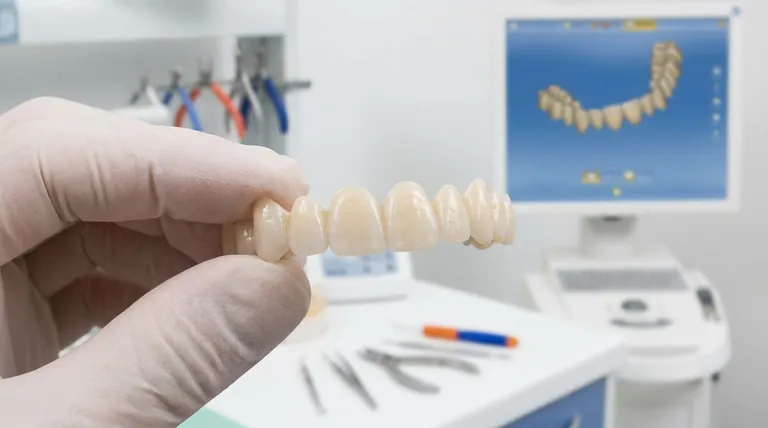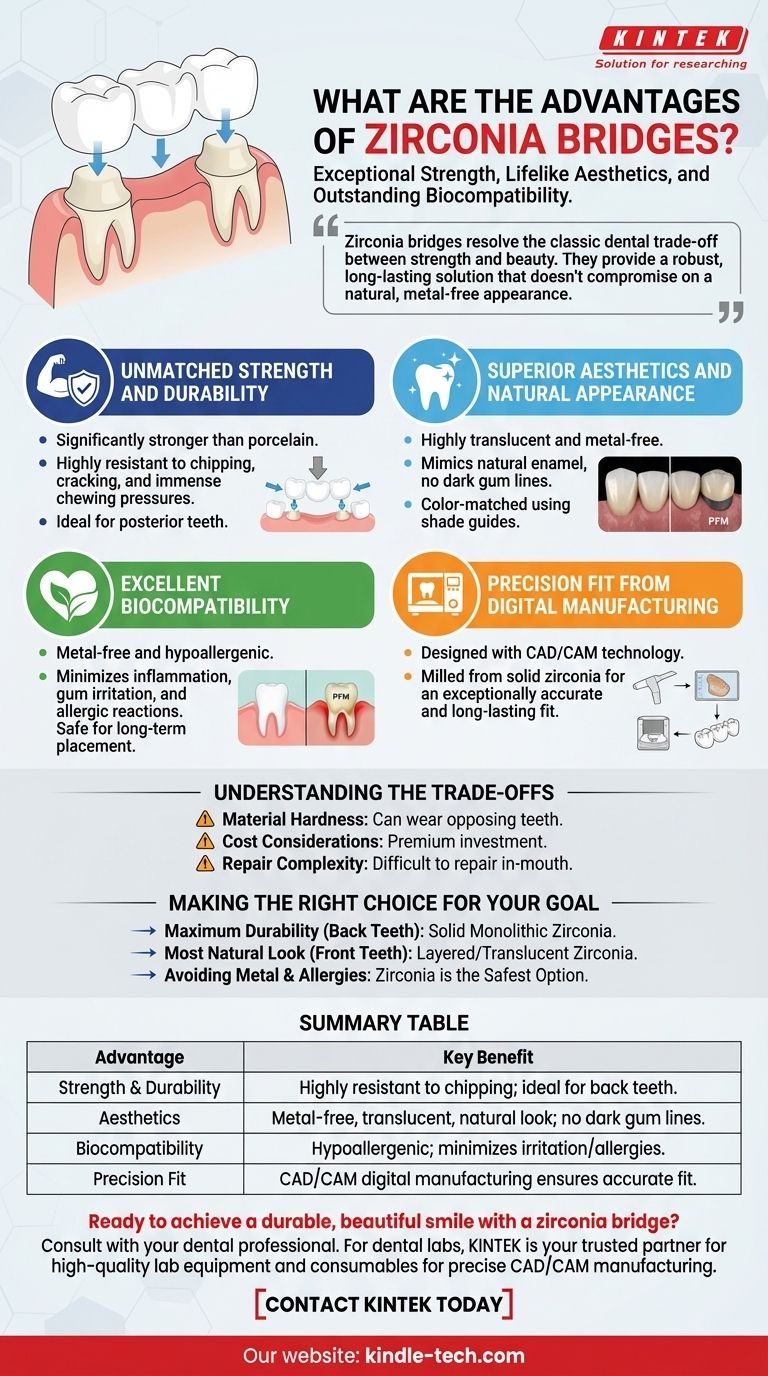The primary advantages of zirconia bridges are their exceptional strength, lifelike aesthetics, and outstanding biocompatibility. Unlike traditional options, zirconia combines the durability of metal with the natural appearance of ceramic, making it a premier material for modern dental restorations.
Zirconia bridges resolve the classic dental trade-off between strength and beauty. They provide a robust, long-lasting solution that doesn't compromise on a natural, metal-free appearance.

The Core Strengths of Zirconia
Zirconia's unique properties make it an increasingly popular choice for dental bridges, which are used to replace one or more missing teeth by anchoring to adjacent natural teeth or implants.
Unmatched Strength and Durability
Zirconia is a type of ceramic that is significantly stronger than traditional porcelain. This inherent toughness makes it highly resistant to chipping, cracking, and the immense pressures of chewing.
Because of this strength, zirconia bridges are an excellent choice for restorations anywhere in the mouth, including the posterior (back) teeth where biting forces are greatest.
Superior Aesthetics and Natural Appearance
Modern zirconia can be manufactured to be highly translucent, allowing it to mimic the light-handling properties of natural tooth enamel. This avoids the opaque or "chalky" look of some older ceramic materials.
As noted, restorations can be perfectly color-matched to your existing teeth using industry-standard shade guides. This precision, combined with zirconia's metal-free composition, eliminates the risk of a dark or gray line appearing at the gum line, a common issue with porcelain-fused-to-metal (PFM) bridges.
Excellent Biocompatibility
Biocompatibility refers to how a material interacts with living tissue. Zirconia is highly biocompatible, meaning it is extremely unlikely to cause inflammation, gum irritation, or allergic reactions.
This makes it a safe and comfortable option for long-term placement in the body, especially for patients with sensitivities to the metal alloys used in PFM restorations.
Precision Fit from Digital Manufacturing
The vast majority of zirconia bridges are designed and created using CAD/CAM (Computer-Aided Design/Computer-Aided Manufacturing) technology.
Your dentist takes a digital scan of your teeth, which is used to design a precise virtual model of the bridge. This model is then sent to a milling machine that carves the bridge from a solid block of zirconia. This digital workflow results in an exceptionally accurate fit, which is critical for the health of the supporting teeth and the longevity of the bridge.
Understanding the Trade-offs
While zirconia offers significant advantages, it is important to have a complete picture. A trusted advisor must present a balanced view.
Material Hardness
Zirconia is harder than natural tooth enamel. While this contributes to its durability, there is a possibility it can cause accelerated wear on the opposing natural teeth over time. This is a key consideration your dentist will evaluate.
Cost Considerations
The advanced material and digital manufacturing process often make zirconia bridges a more premium investment compared to traditional PFM or full-metal options. However, their longevity and aesthetic superiority often justify the initial cost.
Repair Complexity
If a zirconia bridge does chip or fracture, it can be more difficult to repair inside the mouth compared to other materials. In most cases, a damaged restoration would need to be replaced.
Making the Right Choice for Your Goal
The best material for your dental bridge depends on the location of the missing tooth, your aesthetic priorities, and your clinical needs.
- If your primary focus is maximum durability for back teeth: Solid, or "monolithic," zirconia is an unparalleled choice for withstanding heavy chewing forces.
- If your primary focus is the most natural look for front teeth: A layered or highly translucent zirconia provides the best aesthetic outcome, seamlessly blending with your smile.
- If your primary focus is avoiding metal and potential allergies: Zirconia's excellent biocompatibility makes it the safest and most tissue-friendly option.
Ultimately, a thorough discussion with your dental professional will determine if zirconia's unique blend of strength and beauty is the ideal solution for restoring your smile.
Summary Table:
| Advantage | Key Benefit |
|---|---|
| Strength & Durability | Highly resistant to chipping and cracking, ideal for back teeth. |
| Aesthetics | Metal-free, translucent appearance for a natural look; no dark gum lines. |
| Biocompatibility | Hypoallergenic; minimizes risk of irritation or allergic reactions. |
| Precision Fit | CAD/CAM digital manufacturing ensures an accurate, long-lasting fit. |
Ready to achieve a durable, beautiful smile with a zirconia bridge?
Consulting with your dental professional is the best next step. For dental labs crafting these premium restorations, KINTEK is your trusted partner. We specialize in the high-quality lab equipment and consumables needed for precise CAD/CAM manufacturing, ensuring your zirconia bridges meet the highest standards of strength and aesthetics.
Contact KINTEK today to learn how our solutions can support your laboratory's success in creating superior dental restorations.
Visual Guide

Related Products
People Also Ask
- How should the PTFE electrode stand be adjusted to fit the electrolytic cell? Ensure Maximum Stability for Your Experiments
- What is a sintered glass funnel used for? Achieve High-Purity Filtration in Your Lab
- How can auxiliary equipment be installed on the PTFE electrode stand? Ensure Stable & Interference-Free Setup
- What are the common sterilization methods in a laboratory? A Guide to Choosing the Right Technique
- What maintenance procedures are recommended for a PTFE cleaning basket? Extend Equipment Life & Ensure Process Purity
